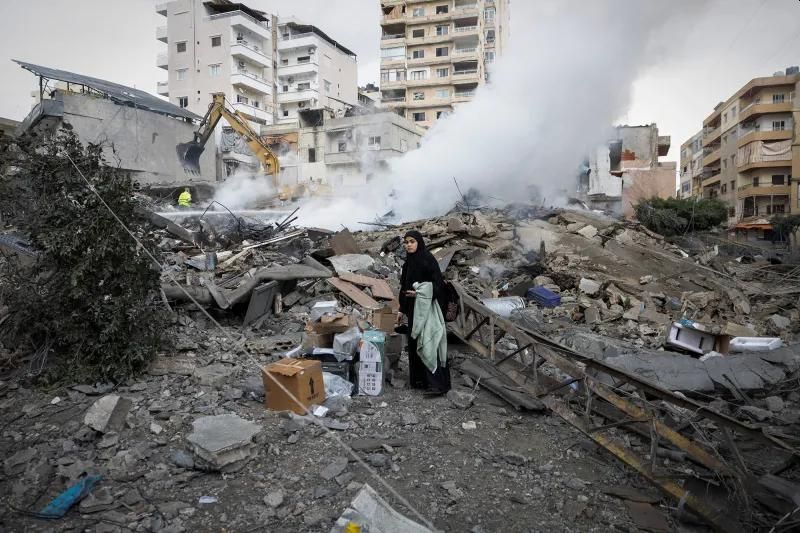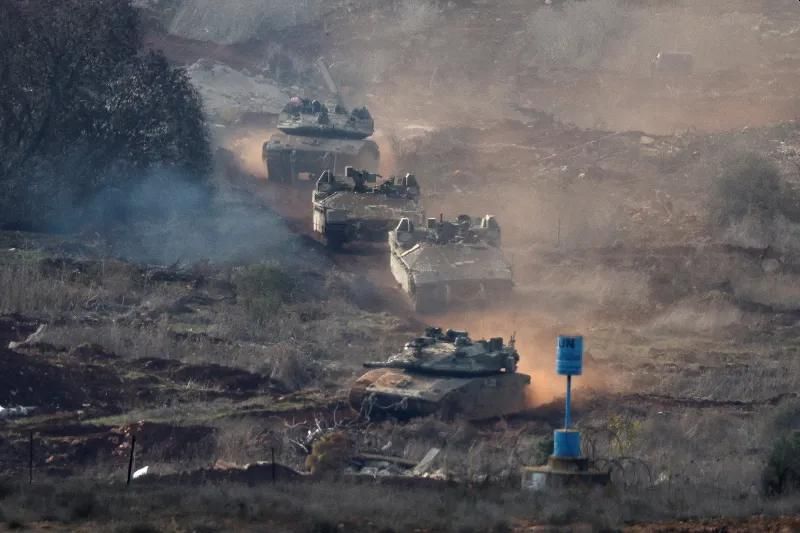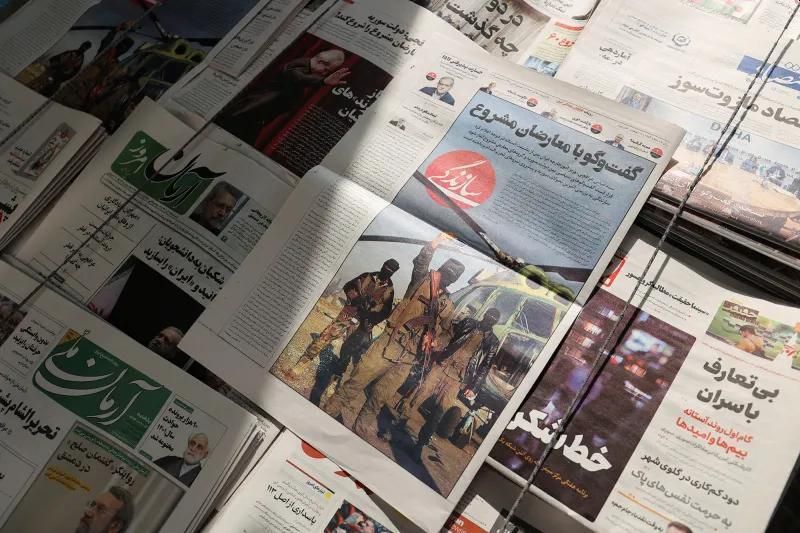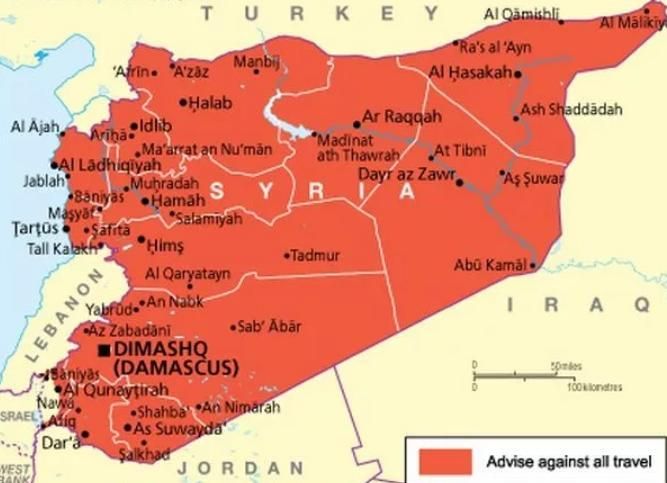By Eric Vandenbroeck and co-workers
On October 3, 2023,
Iranian Supreme Leader Ali Khamenei addressed a large crowd of government officials
and international visitors in Tehran. As he approached his conclusion,
Khamenei’s remarks turned to Israel—the Islamic Republic’s self-proclaimed
nemesis. Invoking a verse from the Koran, Khamenei insisted that the Jewish
state would “die of [its] rage.” He reminded the audience that the Iranian
theocracy’s founder, Ruhollah Khomeini, had described Israel as a cancer. He
ended his speech with a prediction: “This cancer will be eradicated, God
willing, at the hands of the Palestinian people and the resistance forces
throughout the region.”
Four days later,
sirens sounded as rockets flew out of Gaza and into southern Israel. More than
1,000 Palestinian militants followed, breaching the border barricade on
motorcycles and jeeps, swarming from boats on the sea, and paragliding in from
the air. In less than 24 hours, the militants killed 1,180 Israelis and
captured 251 more. The massacre committed by Hamas and other Palestinian
fighters was the deadliest act of anti-Jewish violence since the Holocaust. It
precipitated a ferocious Israeli military response that has wiped out Hamas’s
leadership and eliminated thousands of the group’s fighters, while also killing
tens of thousands of Palestinian civilians and devastating Gaza’s
infrastructure.
Although Tehran was
not directly involved in the October 7 attack, Iran’s leaders were eager to
exploit its aftermath in hopes of fulfilling Khamenei’s prophecy. At first,
Iran entered the war by following its well-honed playbook: posturing
diplomatically against escalation while rallying its proxy militias to assault
Israel. But on April 13, Iranian leaders shifted course, launching a massive
barrage of missiles and drones at Israel, the first time that Iran had directly
attacked Israeli territory from Iranian territory.
Israel was
spectacularly successful in working with the United States and its Arab
partners to blunt those strikes. It then retaliated against Iran and its
proxies without prompting more attacks, containing escalation. And the fall of
Syrian President Bashar al-Assad’s regime only strengthens Israel’s upper hand
over Iran. Still, history suggests that the Islamic Republic is unlikely to be
chastened. Instead, the normalization of direct military conflict between Iran
and Israel is a seismic shift that creates a profoundly unstable equilibrium.
By lowering the threshold for direct strikes, the tit for tat has boosted the
odds that the two most powerful states in the Middle East will fight a
full-scale war, one that could draw in the United States and have a devastating
effect on the region and the global economy. Even if such a war does not break
out, a weakened Iran may seek to insulate itself by acquiring a nuclear weapon,
causing a wider wave of proliferation. Preventing such a future will thus be an
essential challenge for U.S. President-elect Donald Trump, who must leverage
his penchant for chaos to forge a regional deal.

A Rising Power
Iran and Israel were
not always mortal enemies. Under Mohammad Reza Shah Pahlavi, the monarch who
ruled Iran for decades until the 1979 revolution, Tehran cultivated a
cooperative and mutually beneficial security and economic relationship with the
Jewish state. Israeli leaders, in turn, courted Iran to ease their
international isolation and counter the hostility of their Arab neighbors.
The Iranian
Revolution turned that relationship on its head. Iran’s new rulers—who came
from the Shiite clergy, despised Israel. Some, steeped in anti-Semitic
conspiracy theories, even viewed Israel as an infidel transgressor. (The ties
between the Shah and Israel were, in fact, one of the factors that helped
galvanize religious opposition to his rule.) Before the revolution, in an
infamous 1963 sermon that precipitated his expulsion from Iran, Khomeini
inveighed against Israel as the enemy of Islam and the religious class in Iran.
He continued to weave similar themes throughout his speeches after the
revolution elevated him to head of state.
Under Khomeini’s
leadership, the Islamic Republic fused this deep-seated ideological antipathy
toward Israel with a determination to upend the regional order and assist
oppressed peoples, especially the Palestinians. Tehran began this process by
intervening in Lebanon, which was in the throes of its long civil war when Iran
became a theocracy. After Israel’s 1982 invasion of the country, Iran offered
Lebanese Shiite groups such as Hezbollah military
and technical aid, developing a model for terrorizing its adversaries through
suicide bombings, assassinations, and hostage-taking. Tehran also began
championing the Palestinian cause as a way to win the
hearts and minds of the Middle East’s many Sunni Muslims, who otherwise had
little reason to side with a fundamentalist Shiite regime.
Accustomed to dealing
with the shah, Israel initially sought to forge quiet connections with Iran’s
revolutionary state, which it viewed as anomalous and impermanent. Israeli
officials even maintained a sizable arms pipeline to Tehran after Iraqi President
Saddam Hussein’s 1980 invasion of Iran, in hopes of strengthening moderate
Iranian leaders and prolonging the conflict against Baghdad. (The Israelis saw
Iraq as a more serious threat.) But this gambit ended badly after the
involvement of U.S. officials, who sought to use the sales of American weapons
to Tehran, including those sold by Israel, to induce Tehran’s help in freeing
U.S. hostages in the Middle East and to covertly fund Nicaragua’s contra
rebels. The result was an embarrassing scandal for the Reagan administration
and a further hardening of Iran’s revolutionary regime. In this way, the
Iran-contra debacle helped put to rest any Israeli illusions that revolutionary
Iran was ephemeral or non-threatening.
The end of the
Iran-Iraq War in 1988, meanwhile, gave Iran the capacity to more seriously
challenge Israel. The Islamic Republic may have emerged from that conflict
battered and impoverished, but the fighting helped the clerical regime
consolidate its grip on power. It also meant the Iranian military needed a new
mission. Even as Israel and the Palestinians took hesitant steps toward
conflict resolution and a two-state solution in the 1990s, Tehran expanded its
investments in violent opposition to the peace process and to Israel overall.
It also accelerated the revival of Iran’s pre-revolutionary nuclear program.
Events in the
following decade further bolstered the Iranian regime. The U.S. military
interventions in Afghanistan and Iraq dethroned two of Tehran’s most proximate
adversaries, the Taliban and Saddam, giving Iran more room to maneuver. Those
U.S. operations also intensified paranoia in Tehran that Washington was trying
to strangle the Islamic Republic, stoking the regime’s determination to drive
U.S. troops out of the region. The result was an Iran both more able and more
willing to arm its proxy network, including by funneling weapons to Palestinian
militants.
During this same
period, the full scope of Iran’s nuclear ambitions began to come into view. In
2002, an Iranian opposition group exposed previously undisclosed nuclear sites
intended to produce fuels that could be used for weapons, in violation of Tehran’s
obligations under the Nuclear Nonproliferation Treaty. For Israel, Russia, the
United States, and other leading powers, these revelations confirmed that the
theocracy was developing the infrastructure to acquire nuclear arms and
potentially transfer them to its surrogates and partners. Ultimately, the
International Atomic Energy Agency referred the issue to the UN Security
Council, resulting in an unprecedented suite of multinational economic
sanctions on Iran.
Those restrictions
hit Tehran’s pocketbook, but they did not disrupt its regional rise, which was
further aided by the Arab Spring in 2010–11. At first, the spread of
revolutions and civil war across the Middle East challenged the Islamic
Republic, especially when the unrest threatened one of Iran’s most valuable
partners—Assad. But with help from Hezbollah and Russia, Iran managed to prop
up Assad for more than a decade. By improving its position in Syria, Tehran was
also able to ensure that Hezbollah remained the dominant force in Lebanon,
expanding the group’s arsenal of precision-guided missiles and rockets as well
as the means to produce them. And Iran further seized on growing regional
chaos, such as the civil war in Yemen, to expand its reach and enhance the
capabilities of its partners. By the end of the 2010s, Tehran had developed the
ability to project power across the Middle East and coordinate its network of
militias.

Playing With Fire
Israel watched warily
as Iran grew more capable. But for years, and despite many threats, it avoided
directly attacking the country. The Obama administration succeeded in
dissuading Israeli Prime Minister Benjamin Netanyahu from launching strikes on
Iran’s nuclear program in 2012. Tehran, Washington, and five other world powers
later inked an agreement to limit Iran’s nuclear program in 2015, despite
ferocious lobbying from Israeli leaders.
Instead, Israel
contented itself with creative and reasonably effective alternatives to direct
military action. Through clandestine operations and cyberattacks, the country
sabotaged key Iranian nuclear facilities. It assassinated nuclear scientists
and military officers, and it stole archival records that demonstrated the true
extent of Iran’s nuclear activities, which the regime had tried to hide.
Perhaps most important, Israel built a potent intelligence network that kept
the Iranian regime off balance.
Israel also sought to
turn up the heat on Iran by directly attacking Tehran’s allies and striking its
resources outside the country. What began in 2013 as opportunistic bombings of
Hezbollah supply lines within Syria had transformed by 2017 into a systematic
military campaign against Iranian assets and proxies across the region. This
campaign scored significant successes, including a series of strikes in the
summer of 2019 on Iranian weapons depots in Iraq, missile production facilities
in Lebanon, and Iranian-backed fighters in Syria. But by remaining below the
threshold that would provoke Iranian retaliation, Israel fell short of
achieving decisive setbacks against Hezbollah or Iran.
Israel’s escalation in
Iran and Syria coincided with Trump’s first term, in which Washington assumed a
much harsher stance toward the Islamic Republic. Trump pulled the United States
out of the Iran nuclear deal in 2018 and imposed what he called “maximum
pressure” economic sanctions on Iran in hopes of extracting far-reaching
concessions. Tehran’s response offers a case study in its cagey calculus. For
the first year of those sanctions, Iranian leaders exhibited remarkable
restraint, only to pivot dramatically and launch a series of counterattacks,
including strikes on Persian Gulf shipping and Saudi oil facilities. This was
not wanton violence: Iranian leaders hoped that confrontation might change
Washington’s cost-benefit analysis and force an end to maximum pressure. They did not succeed—but from Tehran’s point of view, the
maneuver did not fail, either. To Tehran, the best defense is often a good
offense, and its aggressive actions signaled to the world that the regime was
willing to impose real costs on countries that bucked it.
Israeli tanks returning from southern Lebanon,
December 2024

Recent tit-for-tat
exchanges between Iran and Israel betray a similar logic, and they have moved
the war between the two states into new territory. After Israel bombed an
Iranian consulate building in Syria in April, Iran launched its unprecedented
direct attack, firing more than 350 ballistic and cruise missiles and drones
straight at its enemy. This attack, like past ones, was calculated and clearly
designed to send a message. Iran, after all, telegraphed the attack well in
advance. And Israel, thanks in no small part to the help of neighboring Arab
states, was able to repel Iran’s bombardment. But the coordinated volley of
missiles and drones was not simply performative. “This wasn’t a small-scale or
a chest-thumping show of force,” noted Major Benjamin Coffey, one of the U.S.
Air Force pilots who helped thwart the Iranian barrage. “This was an attack
designed to cause significant damage, to kill, to destroy.”
The death of Iranian
President Ebrahim Raisi in a May 2024 helicopter accident briefly distracted
the theocracy and appeared to disrupt the escalatory spiral. But it was not
long before the conflict flared again. In August, Israel assassinated the Hamas
political leader Ismail Haniyeh at an official Iranian guesthouse in Tehran,
only hours after Haniyeh had met with Khamenei and attended the inauguration of
the country’s new president, Masoud Pezeshkian. Less than two months later,
Israel escalated in Lebanon, laying waste to decades of Iranian investment in
Hezbollah in an abrupt and humiliating fashion. Via remote control, Israel
detonated tiny explosives it had secretly implanted in thousands of pagers used
by Hezbollah operatives, disrupting the group’s command and control. Israeli
forces then killed nearly the entire upper echelon of Hezbollah’s leadership,
including its longtime chief, Hassan Nasrallah, and destroyed much of the
group’s weaponry.
This onslaught
produced not just a much weaker Hezbollah but a much weaker Iran. For more than
40 years, Hezbollah had been Tehran’s ace in the hole: the country’s inaugural
franchise and the nucleus in its loose network of partners and proxies. Its
arsenal of missiles was intended to be the first line of defense for Iran.
Crippling such a key asset, even if only temporarily, severely undercut Iran’s
stature and power in the region. The loss of Nasrallah was especially
devastating for Iran’s leadership. Nasrallah and Khamenei had known each other
since Hezbollah’s earliest days. Nasrallah spoke Persian, had lived for a time
in Iran, and was the only major figure in the region who considered Iran’s
supreme leader to be his spiritual guide.
It was thus entirely
predictable, and perhaps even inevitable—that Tehran would respond to his death
with force, as it did with another salvo of missiles on October 1. Yet once
again, U.S. and Israeli preparation and coordination prevented casualties and
any serious physical damage. After some brief suspense, Israel undertook an
elegant and effective set of strikes that significantly weakened Iran’s air
defenses and its missile, drone, and nuclear program without provoking
retaliation. This strike, together with the subsequent collapse of Assad’s
brutal government, has shattered Iran’s existing regional strategy.

Appetite for Destruction
For now, the direct
attacks between Iran and Israel have provided the latter with the upper hand.
Iran’s capabilities, defensive and offensive alike—have been degraded. Israel,
after the catastrophic failure of October 7, looks stronger than ever. By galvanizing
Arab states to help repel Iran’s April attack, the Israelis have shown that
Arab governments are willing to join the Jewish state in deterring Iran,
despite the sympathy for the Palestinians among Arab populations.
Yet Iran and Israel,
and the region as a whole, are facing a difficult
predicament. Israel has achieved a significant victory, but both Iranian and
Israeli leaders believe that the threat posed by the other remains existential
and unyielding. In their public posture and rhetoric, both governments seek to
portray the other as being on the ropes. After Israel’s October strike on Iran,
Netanyahu boasted, “Israel has greater freedom of action in Iran today than
ever before. We can reach anywhere in Iran as needed.” But for Khamenei, the
setbacks of Iran’s proxies are meaningless; in his telling, Hamas and Hezbollah
are victorious simply because they survived, and Israel’s destruction is only a
matter of time. “The world and the region will see the day when the Zionist
regime will be clearly defeated,” he said in early November.
Given Iran’s losses
and its newly heightened vulnerability at home, this posture may be bravado.
And if Tehran is serious, its leaders may be gravely miscalculating. Still,
over the past 45 years, Iran’s leadership has navigated many significant
setbacks with surprising agility. Two of the secrets to the regime’s success
are its tendency to embrace aggression under pressure and its readiness to play
the long game: to retrench or pivot as necessary, to creatively deploy its
limited resources and relationships, and to engage in asymmetric attacks to
achieve leverage over more powerful adversaries. It could do so again today.
Consider the record.
In January 2020, the Trump administration assassinated Qasem Soleimani, the
commander of Iran’s Quds Force—the branch of Iran’s Islamic Revolutionary Guard
Corps in charge of managing relations with Iran’s allies and proxies. At first,
the killing seemed like a symbolic and operational disaster for Tehran, given
just how key Soleimani was to its foreign policy. Yet his death ultimately had
little enduring effect on the strength, durability, or efficacy of Iran’s axis
of resistance. Similarly, in 1992, when Israel killed Abbas al-Musawi,
Hezbollah’s leader at the time, it paved the way for the ascension of
Nasrallah, who proved to be a far more effective and deadly adversary. A month
later, Hezbollah retaliated by orchestrating the deadly bombing of Israel’s
embassy in Argentina.
The evisceration of
Tehran’s most valuable assets, Hezbollah and the Assad regime, is a
catastrophic blow for the Islamic Republic. But a weakened Iran is not
necessarily a less dangerous Iran. Iran is “staring you in the eye” and “will
fight you to the end,” Hossein Salami, the commander of Iran’s Revolutionary
Guards, declared to Israel in November. “We will not allow you to dominate the
fate of Muslims. You will receive painful blows—keep awaiting revenge. ”This may be garden-variety Iranian bluster, but it would be
a mistake and out of step with historical precedent to presume that even a
massive strategic reversal will induce Iranian quiescence.
There is another sign
that Iran may be upping the ante to counterbalance its new vulnerabilities. For
the first time in two decades, important voices within the country are openly
calling for Tehran to embrace nuclear weapons. In the past, several senior
Iranian officials, including a previous foreign minister and a previous head of
the country’s atomic energy agency, had hinted that they had achieved the
ability to produce a weapon but had opted not to. In November 2024, however,
Iranian Foreign Minister Abbas Araghchi said that influential officials in the
regime view that restraint as self-defeating. Hard-liners in Iran’s parliament
have publicly asked Khamenei to reconsider his religious decision that forbids
the development of nuclear weapons. If the fundamental rules of the game have
been transformed since October 7, then Iran’s defense
doctrine may undergo a similar evolution. A truculent Trump administration that
supports an unleashed Israel could, in particular, accelerate
Iran’s nuclear timeline and prompt Tehran to openly embrace weaponization,
something the Iranian regime has spent decades dodging.

Chaos Agent
Trump’s second
administration will take office determined to get tough on Tehran, just as his
first one did. His incoming team has promised to ratchet up economic pressure
on the Islamic Republic. The president-elect himself warned the Iranians that
he would “blow your largest cities and the country itself to smithereens,” if
they sought to assassinate him, as multiple news outlets reported.
Meanwhile, the
incoming national security adviser, Mike Waltz, has lambasted President Joe
Biden for imposing restrictions on Israel as it prosecutes its war in Gaza.
Unlike the Biden administration, then, the Trump team may have little regard
for the potential blowback from a sustained attempt to erode the capabilities
of the Houthis in Yemen and Iraq’s Shiite militias. If so, the region could be
headed for more bloodshed. Should Israel or the United States take off their
gloves in Iraq and Yemen, they could destabilize Iraq and prompt the Houthis to
target U.S. partners in the Middle East: Jordan, Saudi Arabia, and the United
Arab Emirates (UAE). That could complicate the planned phase-down of U.S.
troops in Iraq and leave a precarious power vacuum in the heart of the Arab
world that Tehran and other extremists would seek to exploit. So could
uncertainty regarding the future of Lebanon and Syria. Yet Trump’s policy may
prove more nuanced than unwavering confrontation. For starters, the new
administration will find that the tools at its disposal are less effective than
when Trump deployed them during his first term. His maximum pressure sanctions,
for example, succeeded in slashing Iran’s oil exports and revenues thanks to
cooperation from China, which Beijing may not be willing to repeat. The
smuggling networks that enable Iranian oil to reach China have become more
elaborate and more difficult to counter through sanctions designations alone.
Any significant new economic coercion could also face headwinds from
Washington’s crucial Gulf allies, whose leaders now prefer to co-opt rather
than confront Tehran.
Then there are
Trump’s own views on Iran. The president-elect has suggested there is a method
to his madness—and that he desires a deal. During his 2024 campaign, Trump
disavowed regime change and declared that he wanted Iran “to be a very
successful country.” He has recently suggested that had he won in 2020, he
would have concluded an agreement with Tehran “within one week after the
election.” And Trump appears to have greenlighted early engagement with Iranian
officials this time around, having sent one of his closest confidants, the
billionaire Elon Musk, to meet with the country’s UN ambassador in November.
A newspaper with a picture of Syrian rebel fighters,
Tehran, December 2024

The new
administration will surely take a permissive approach to Israeli territorial
ambitions. But Trump also says he wants to end the war in Gaza and to expand
the Abraham Accords by adding Saudi Arabia. He wants to avoid further U.S.
military commitments while lowering energy prices, creating a more docile
China, and terminating Iran’s nuclear program. These aims require difficult
tradeoffs, and they will necessitate a more sophisticated strategy than merely
attacking Iran and its proxies.
If past
is prelude, Trump’s resulting approach will likely be highly
disruptive—especially since some of his goals are mutually incompatible. That
may not seem like the best recipe for stability in the Middle East. Yet this
may be just the moment for the unconventional, unpredictable, and unintentional
chaos that appears to be on order from a Trump presidency. A dexterous
Washington, unencumbered by any fidelity to principles or predictability, might
just succeed by brandishing American muscle alongside a transparent infatuation
with dealmaking. Trump’s grand ambitions and his transactional approach to
foreign policy are surprisingly well suited to today’s Middle East, where
regime interests and opportunistic investments are the lingua franca.
To succeed, Trump
will have to manage the competing views and priorities of his own
administration’s staffers. But an unsentimental assessment of the regional
landscape offers some sense of how Trump could proceed. He might start, as he
did in his first term, in the Gulf. The Gulf states desperately want an end to
the war in Gaza, which would serve their own economic and security interests as
well as Israel’s. The UAE has been in discussions with Washington about helping
establish a postwar Palestinian government in Gaza and obtaining security and
reconstruction funding. Trump could continue these conversations and use them
to help end Israel’s war. The Gulf states could also help Trump forge a new
deal with Iran. Both Saudi Arabia and the UAE have strong channels of
communication with Tehran, which Trump could tap into. The Arab world would
certainly welcome an agreement that prevents a full-scale war, which would have
catastrophic consequences.

This confluence of
interests is useful but hardly sufficient to achieve the outcomes Trump
desires. That is where the president-elect’s volatility and ruthlessness could
be an unexpected asset. If Trump reinstates meaningful economic pressure on
Iran and gives Israel some additional leeway for military action, he might
better demonstrate U.S. capabilities and thus force Iran to reverse its
current, uncompromising policy positions. A muscular U.S. approach has paid
dividends in the past with an Iranian leadership whose foremost interest is in
regime survival. Such an approach would likely be an improvement over that of
the Biden administration, which relied almost exclusively on conciliation that
Iran saw as weak and desperate. The result of the shift could be a real deal of
the century: an abatement of the multipronged conflicts raging in the Middle
East, a political horizon and reconstruction for the Palestinians and the
Lebanese, and some nominal concessions from Tehran on its nuclear program and
regional malfeasance.
Forging this deal will still be extremely difficult to
achieve. During his first term, Trump’s unconventional diplomacy with another
recalcitrant nuclear power, North Korea, ultimately went nowhere, and overall his administration achieved few notable
breakthroughs in dealing with adversarial powers. Even if realized, a deal
would not likely endure for very long. Iran’s leadership is steeped in
antagonism toward both Israel and the United States, and the regime’s
investment in its nuclear program and proxy network has been key to its
survival strategy. Netanyahu, for his part, has found that a maximalist
military approach yields spectacular strategic dividends along with domestic
political benefits. And there is no shortage of other spoilers in this combustible
region.
But even an ephemeral
set of understandings could reduce the temperature in the Middle East. That
would, in turn, enable Washington and the world to turn their attention to more
daunting challenges, especially China and Russia. And any deal that stanches
some of the bloodshed and reduces some of the risks, if only temporarily.
For updates click hompage here